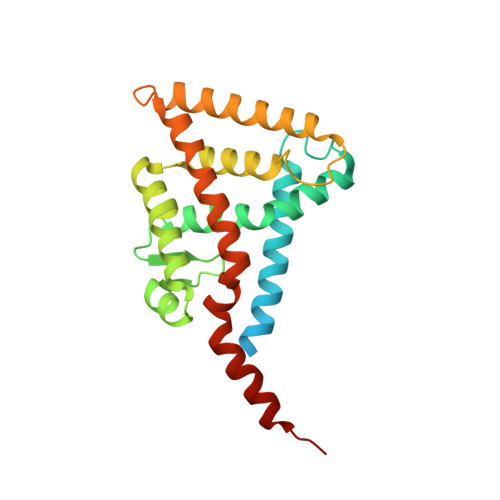Modulation of nongenomic activation of PI3K signalling by tetramerization of N-terminally-cleaved RXR alpha.
Chen, L., Aleshin, A.E., Alitongbieke, G., Zhou, Y., Zhang, X., Ye, X., Hu, M., Ren, G., Chen, Z., Ma, Y., Zhang, D., Liu, S., Gao, W., Cai, L., Wu, L., Zeng, Z., Jiang, F., Liu, J., Zhou, H., Cadwell, G., Liddington, R.C., Su, Y., Zhang, X.K.(2017) Nat Commun 8: 16066-16066
- PubMed: 28714476
- DOI: https://doi.org/10.1038/ncomms16066
- Primary Citation of Related Structures:
5TBP - PubMed Abstract:
Retinoid X receptor-alpha (RXRα) binds to DNA either as homodimers or heterodimers, but it also forms homotetramers whose function is poorly defined. We previously discovered that an N-terminally-cleaved form of RXRα (tRXRα), produced in tumour cells, activates phosphoinositide 3-kinase (PI3K) signalling by binding to the p85α subunit of PI3K and that K-80003, an anti-cancer agent, inhibits this process. Here, we report through crystallographic and biochemical studies that K-80003 binds to and stabilizes tRXRα tetramers via a 'three-pronged' combination of canonical and non-canonical mechanisms. K-80003 binding has no effect on tetramerization of RXRα, owing to the head-tail interaction that is absent in tRXRα. We also identify an LxxLL motif in p85α, which binds to the coactivator-binding groove on tRXRα and dissociates from tRXRα upon tRXRα tetramerization. These results identify conformational selection as the mechanism for inhibiting the nongenomic action of tRXRα and provide molecular insights into the development of RXRα cancer therapeutics.
- School of Pharmaceutical Sciences, Fujian Provincial Key Laboratory of Innovative Drug Target Research, Xiamen University, Xiamen 361102, China.
Organizational Affiliation:




















